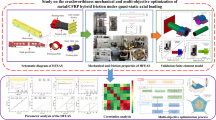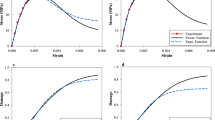Abstract
To qualitatively understand the deformation processes and damages in the human body caused by high-speed impact, we conducted experimental and computational investigations for bullet penetration into viscoelastic ballistic gelatin blocks. Because it is difficult to measure the strain rate-dependent material properties of viscoelastic gelatin blocks during high-speed impact, the material properties that are indirectly defined by the stress relaxation test were used for the computational simulation. We also conducted some firing experiments and analyzed the deformation processes of the structures. In particular, the passing through times and the shapes of the temporary and permanent cavities inside the ballistic gelatin blocks were analyzed and compared. This data reveals that the employed material models, with some modifications for the FE simulation, are sufficient for predicting the high-speed impact behaviors. To investigate the shapes of the permanent cavities and fragments made by bullets inside the gelatin blocks, two-dimensional sectional images were taken by an industrial CT scanner and a three-dimensional CAD model was constructed based on these images.
Similar content being viewed by others
References
G. Seisson, D. Hebert, L. Hallo, J. M. Chevalier, F. Guillet, L. Berthe and M. Boustie, Penetration and cratering experi-ments of graphite by 0.5-mm diameter steel spheres at various impact velocities, Int. J. Impact Eng., 70 (2014) 14–20.
N. Ndompetelo, P. Viot, G. Dyckmans and A. Chabotier, Numerical and experimental study of the impact of small caliber projectiles on ballistic soap, J. Phys. Iv, 134 (2006) 385–390.
C. C. Shi, M. Y. Wang, J. Li and M. S. Li, A model of depth calculation for projectile penetration into dry sand and comparison with experiments, Int. J. Impact Eng., 73 (2014) 112–122.
B. Akers and A. Belmonte, Impact dynamics of a solid sphere falling into a viscoelastic micellar fluid, J. Non-Newton Fluid, 135 (2-3) (2006) 97–108.
D. J. Frew, M. J. Forrestal and J. D. Cargile, The effect of concrete target diameter on projectile deceleration and penetration depth, Int. J. Impact Eng., 32 (10) (2006) 1584–1594.
E. Sevkat, Experimental and numerical approaches for estimating ballistic limit velocities of woven composite beams, Int. J. Impact Eng., 45 (2012) 16–27.
M. G. Perdekamp, S. Pollak, A. Thierauf, E. Strassburger, M. Hunzinger and B. Vennemann, Experimental simulation of reentry shots using a skin-gelatine composite model, Int. J. Legal Med., 123 (5) (2009) 419–425.
A. Dorogoy, D. Rittel and A. Brill, Experimentation and modeling of inclined ballistic impact in thick polycarbonate plates, Int. J. Impact Eng., 38 (10) (2011) 804–814.
S. Hiermaier, Structures under crash and impact: continuum mechanics, discretization and experimental characterization, Springer, New York, USA (2008).
B. Kneubuehl, Wound ballistics: Basics and applications, Springer (2011).
S. Yang, A. Fafitis and A. Wiezel, Nonlinear impact model of a tennis racket and a ball, J. Mech. Sci. Technol., 26 (2) (2012) 315–321.
Y. Kim, J. Yoo and M. Lee, Optimal design of spaced plates under hypervelocity impact, J. Mech. Sci. Technol., 26 (5) (2012) 1567–1575.
Y. F. Deng, W. Zhang, Y. G. Yang, L. Z. Shi and G. Wei, Experimental investigation on the ballistic performance of double-layered plates subjected to impact by projectile of high strength, Int. J. Impact Eng., 70 (2014) 38–49.
M. V. Swain, D. C. Kieser, S. Shah and J. A. Kieser, Projectile penetration into ballistic gelatin, J. Mech. Behav. Biomed., 29 (2014) 385–392.
L. Liu, Y. R. Fan and W. Li, Viscoelastic shock wave in ballistic gelatin behind soft body armor, J. Mech. Behav. Biomed., 34 (2014) 199–207.
F. Bresson, J. Ducouret, J. Peyre, C. Marechal, R. Delille, T. Colard and X. Demondion, Experimental study of the expansion dynamic of 9 mm Parabellum hollow point projectiles in ballistic gelatin, Forensic Sci. Int., 219 (1-3) (2012) 113–118.
Y. K. Wen, C. Xu, H. S. Wang, A. J. Chen and R. C. Batra, Impact of steel spheres on ballistic gelatin at moderate velocities, Int. J. Impact Eng., 62 (2013) 142–151.
I. Ionescu, J. E. Guilkey, M. Berzins, R. M. Kirby and J. A. Weiss, Simulation of soft tissue failure using the material point method, J. Biomech. Eng-T Asme, 128 (6) (2006) 917–924.
D. S. Cronin and C. Falzon, Characterization of 10% Balli-stic Gelatin to Evaluate Temperature, Aging and Strain Rate Effects, Exp. Mech., 51 (7) (2011) 1197–1206.
J. Kwon and G. Subhash, Compressive strain rate sensi-tivity of ballistic gelatin, J. Biomech., 43 (3) (2010) 420–425.
D. S. Cronin and C. Falzon, Dynamic characterization and simulation of ballistic gelain, Proceedings of the SEM Annual Conference, Albuquerque New Mexico, USA (2009).
D. S. Cronin, C. P. Salisbury and C. R. Horst, High rate characterization of low impedance materials using a poly-meric split Hopkinson pressure bar, SEM Conference & Ex-position on Experimental & Applied Mechanics, St. Louis, Missouri (2006).
C. P. Salisbury and D. S. Cronin, Mechanical Properties of Ballistic Gelatin at High Deformation Rates, Exp. Mech., 49 (6) (2009) 829–840.
ANSYS, ANSYS AUTODYN User Mannual.
B. Qiang, J. Greenleaf, M. Oyen and X. M. Zhang, Estimating material elasticity by spherical indentation load-relaxa-tion tests on viscoelastic samples of finite thickness, Ieee T Ultrason Ferr, 58 (7) (2011) 1418–1429.
M. L. Oyen, Spherical indentation creep following ramp loading, J. Mater. Res., 20 (8) (2005) 2094–2100.
M. L. Oyen, Analytical techniques for indentation of viscoelastic materials, Philos. Mag., 86 (33-35) (2006) 5625–5641.
J. M. Mattice, A. G. Lau, M. L. Oyen and R. W. Kent, Spherical indentation load-relaxation of soft biological tissues, J. Mater. Res., 21 (8) (2006) 2003–2010.
X. M. Zhang, B. Qiang and J. Greenleaf, Comparison of the surface wave method and the indentation method for measuring the elasticity of gelatin phantoms of different concentrations, Ultrasonics, 51 (2) (2011) 157–164.
H. W. Kang, J. Kim, Y. Yu and J. Oh, Photoacoustic Response of Magnetic Nanoparticles to Pulsed Laser Irradiation, J. Korean Phys. Soc., 55 (5) (2009) 2224–2228.
G. R. Johson, Fracture characteristics of three metals subjected to various strains, strain rates, temperatures and pressures, Engineering Fracture Mechanics, 21 (1) (1985) 31–48.
M. Aihaiti and R. J. Hemley, Equation of state of ballistic gelatin (II), 55048-EG.1, Carnegie Institute of Washington, DC (2011).
S. P. Mates and R. Rhorer, Dynamic deformation of copperjacketed lead bullets captured by high speed digital image correlation, Proceedings of the SEM Annual Conference, Indianapolis, Indiana, USA (2010) 431–441.
D. S. Preece and V. S. Berg, Bullet impact on steel and Kevlar/steel armor-computer modeling and experimental data, The Proceedings of the ASME Pressure Vessels and Piping Conference-Symposium on Structures Under Ex-treme Loading, San Diego, CA, USA (2004).
V. Astier, L. Thollon, P. J. Arnoux, F. Mouret and C. Brunet, A finite element model of the shoulder for many applications: trauma and orthopaedics, European HyperWorks Technol-ogy Conference, Berlin, Germany (2007).
J. Jussila, Preparing ballistic gelatine -review and proposal for a standard method, Forensic Sci. Int., 141 (2-3) (2004) 91–98.
Author information
Authors and Affiliations
Corresponding author
Additional information
Recommended by Associate Editor Jun-Sik Kim
Gil Ho Yoon received his B.S. degree in mechanical and aerospace engineering from Seoul National University in 1998. And he received his M.S. degree and Ph.D. in mechanical and aerospace engineering from Seoul National University in 2000 and 2004, respectively. Dr. Yoon is currently an associate professor at School of Mechanical Engineering, Hanyang University, Seoul, Republic of Korea.
Jun Su Mo received his B.S. degree in mechanical engineering from Hanyang University in 2013.
Ki Hyun Kim received his B.S. degree in mechanical engineering from Hanyang University in 2013.
Chung Hee Yoon received his B.S. degree in mechanical engineering from Hanyang University in 2013.
Nam Hun Lim received his B.S. degree and M.S. degree in mechanical engineering from Hanyang University in 2012 and 2015, respectively.
Rights and permissions
About this article
Cite this article
Yoon, G.H., Mo, J.S., Kim, K.H. et al. Investigation of bullet penetration in ballistic gelatin via finite element simulation and experiment. J Mech Sci Technol 29, 3747–3759 (2015). https://doi.org/10.1007/s12206-015-0821-7
Received:
Revised:
Accepted:
Published:
Issue Date:
DOI: https://doi.org/10.1007/s12206-015-0821-7




